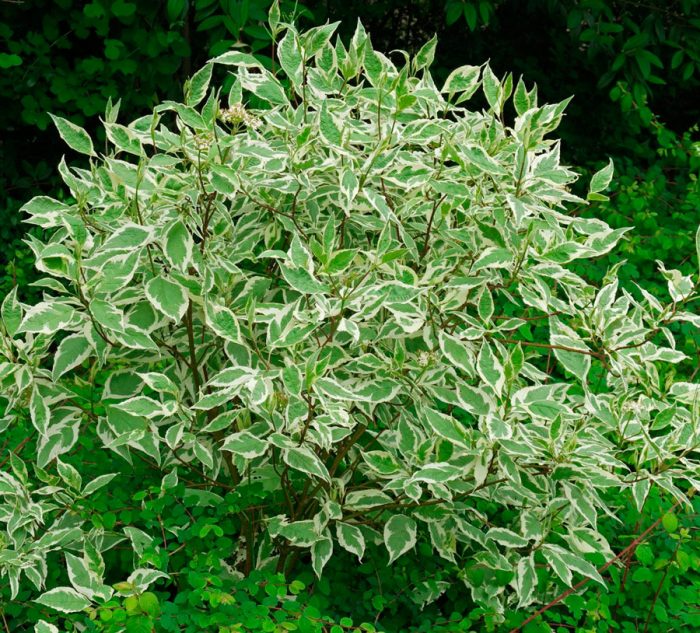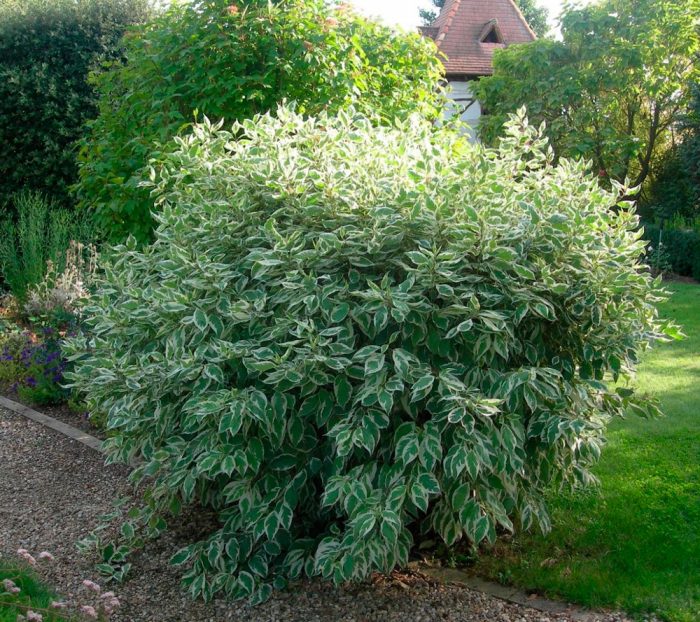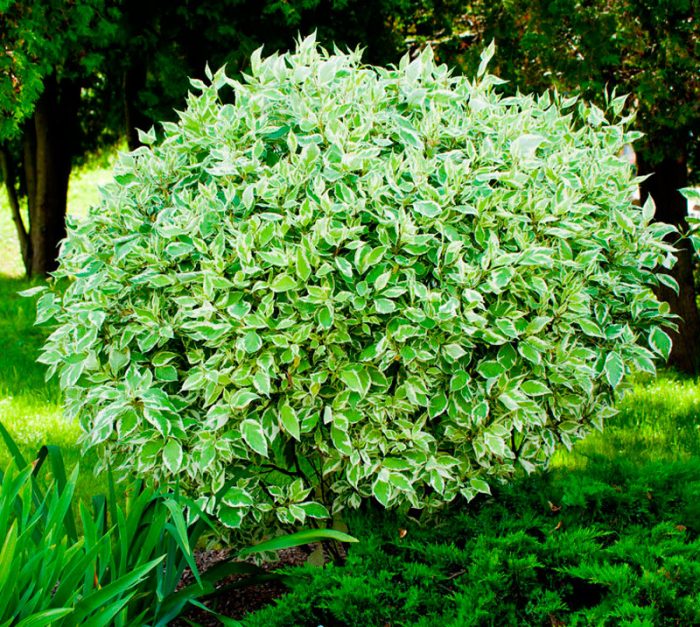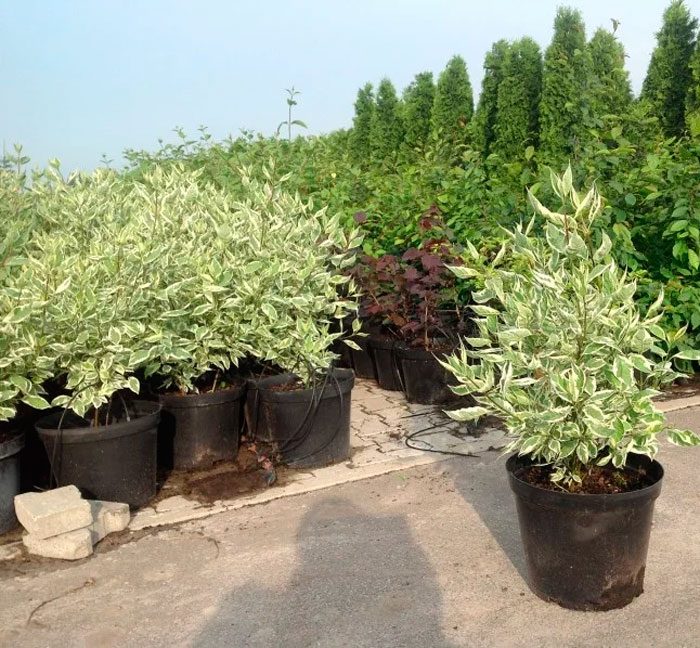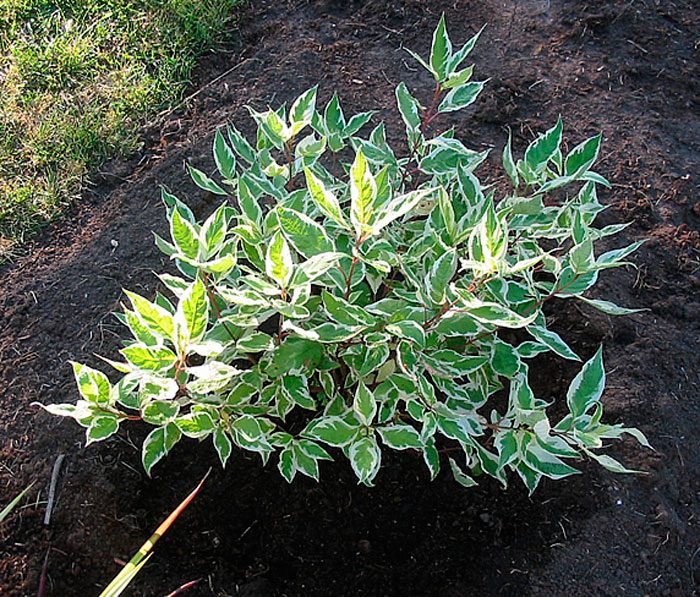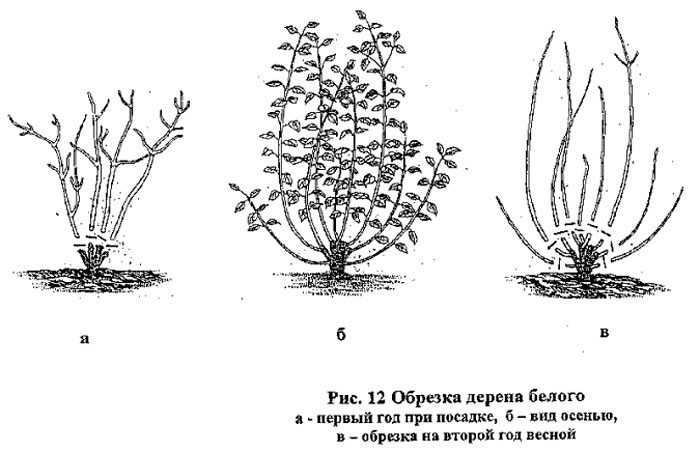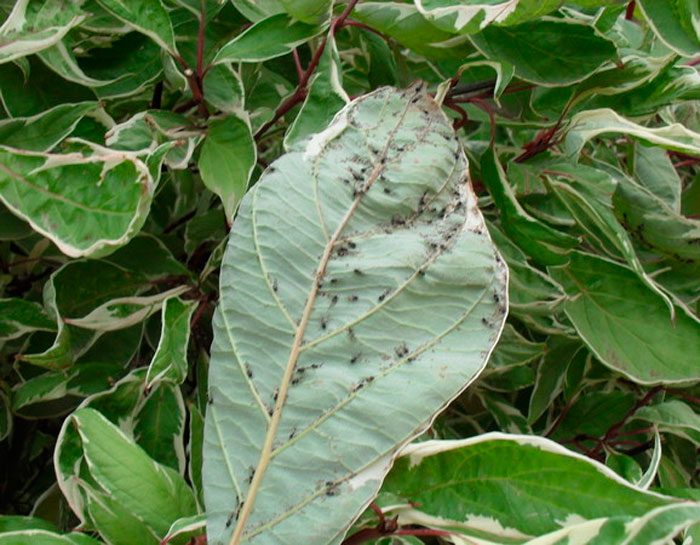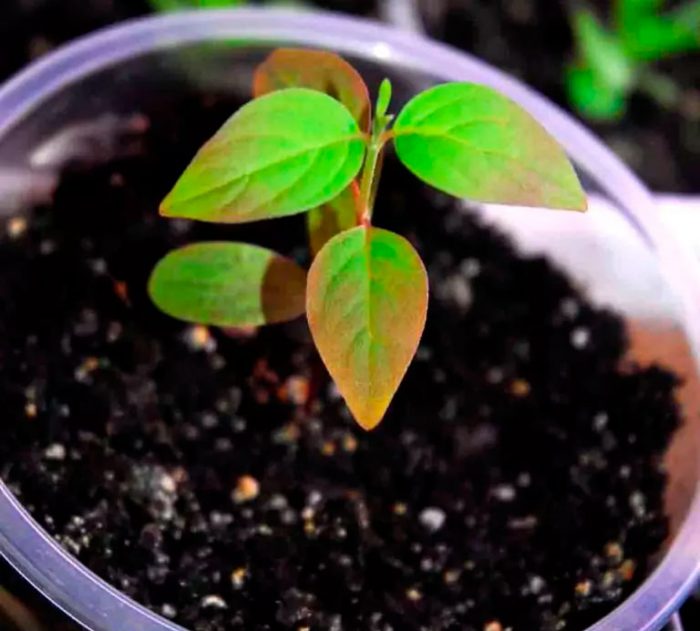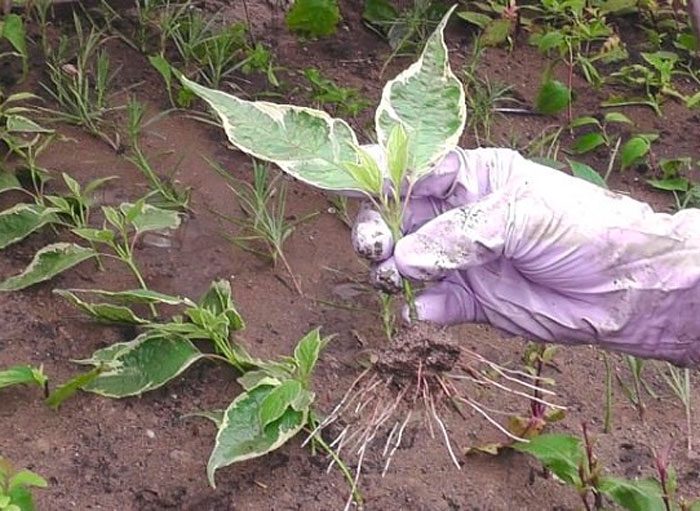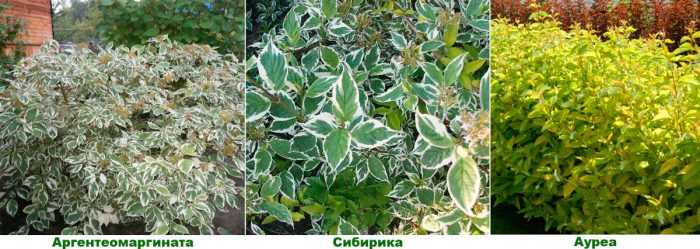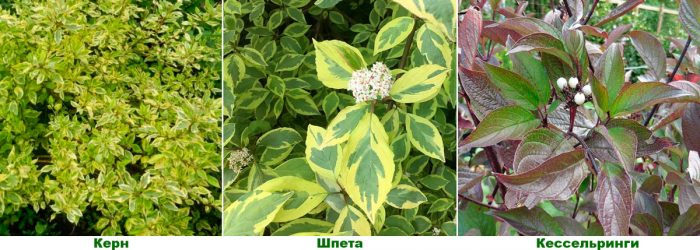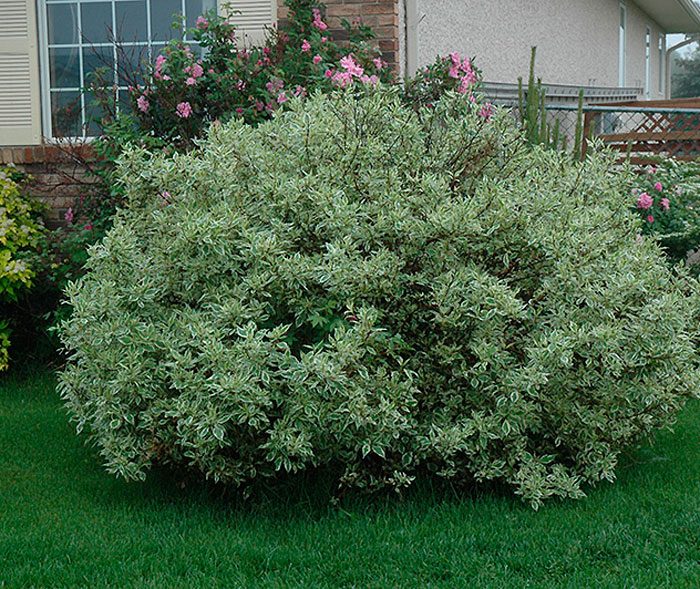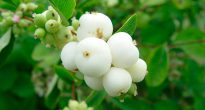The white turf plant (Cornus alba), which is also called white svida, or white svidina, or white telikrania, is a species of the genus Dogwood, belonging to the Cornel family. Also, this plant is considered a very close relative of silky svidina, or offspring. Under natural conditions, this plant can be found in China, Mongolia, Korea, and it also grows in the territory stretching from Japan and the Far East to the European part of Russia. This plant prefers to grow in the undergrowth of dark coniferous swampy forests.
The name of the genus of the white deren means "horn" In this genus, the most widespread shrub is white turf, which is why it is often used in urban landscaping.
Content
Brief description of cultivation
- Bloom... The shrub blooms luxuriantly from early to mid-summer. In the first weeks of autumn, it blooms again.
- Landing... In autumn, during the fall of leaves or in the spring - before sap flow begins.
- Watering... While the plant is young, it is watered once or twice every 7 days. Adult bushes are watered only during a prolonged drought, twice or thrice a month, and from 15 to 20 liters of water are taken per plant.
- Fertilizer... If the soil is nutritious, then the lawn can grow normally without additional fertilizing. In the depleted soil in the spring, 100 to 150 grams of mineral complex fertilizer should be applied to the soil under the bush. And in the summer months, 5 to 7 kilograms of humus are brought under the bush.
- Pruning... After the white dogwood turns 3 years old, they begin to cut it regularly. This is done 2 times a year, or rather: in July and August. Species and varieties that have a rich color bark should be cut off at the very beginning of spring, but only once every few years.
- Reproduction... Layering, seed method and cuttings.
- Pests... Aphids and scale insects are comma-shaped.
- Disease... Powdery mildew.
Features of the white deren
Derain white is a highly branching shrub. Its bare and straight branches are quite flexible, and over the years they begin to bend arcuate. Branches can be colored red-black, red-coral or brown-red. The height of the bush can reach up to 300 cm. The entire opposite leaf plates have an elliptical shape, petioles and pubescence on the surface.Their width can vary from 10 to 70 mm, and their length - from 20 to 100 mm. On the surface of the plate, from three to five arc-shaped veins are clearly distinguishable. The front surface of the foliage has a dark green hue, and the seamy side is pale gray. Lush apical corymbose inflorescences reach 30-50 mm in diameter, they include small white flowers with only 4 petals. Lush flowering of the shrub occurs at the beginning and middle of the summer period. And in the first weeks of autumn, repeated flowering is observed. The fruit is a berry-shaped drupe. Unripe fruits are painted in a pale blue color, which changes to white-blue as it ripens. Ripe drupes become flattened. Fruiting and flowering of white turf is possible only after it turns 2 or 3 years old.
This plant is resistant to heat, cold, tolerates winter well, can grow in the shade, any soil suits it, and it also feels great in urban conditions. It is thanks to its unpretentiousness and spectacular appearance that such a shrub has gained great popularity among gardeners.
Planting white deren in open ground
What time to plant
A seedling of white deren is planted in open ground at the beginning of the spring, and you need to be in time before sap flow begins. Also, this procedure can be carried out in the fall during the leaf fall. Most gardeners prefer to plant such a shrub in the autumn, because in early spring, fully established and rooted seedlings immediately begin to actively grow. When planting a seedling in open ground in the spring, experts advise that during the transfer to the hole, try to take the roots along with a large lump of earth (the more lump, the better). Thanks to this, you will be able to protect the plant from stress that may arise after transplanting.
Since white turf belongs to shade-tolerant plants, it is often planted in shaded areas or even in the shade, for example: along blank fences and walls or under large trees. But it should be remembered that varieties and varieties with variegated foliage need a lot of light, otherwise their leaves may lose their decorative effect.
Landing rules
White derain differs in that almost all types of soil are suitable for it. It grows well on rocky soil, and on light sandstone, and in heavy loamy soil. But it should be noted that the soil must be necessarily neutral.
It is best to use seedlings for planting that are no more than four years old, since they take root faster, and if you cut them off, they will have a large number of young shoots. Before you start planting a seedling, its root system is immersed in water, where it will stay for several hours. During this time, the roots will have time to absorb a sufficient amount of moisture, due to which they will better tolerate the transplant. If a seedling with a closed root system is used for planting, then it is not necessary to soak it first.
The size of the hole should be ¼ part larger than the volume of the root system, taken together with a lump of earth. If the soil on the site is swampy, then white turf can grow normally on it only if you provide it with good drainage. To do this, at the bottom of the landing hole, a drainage layer of sand should be made, which is connected to crushed stone or pieces of brick. In thickness, such a layer should reach about 15 centimeters. Please note that if the groundwater at the site is deep enough or the ground at the site is dry, then drainage is not done at all in the landing pit, or the bottom is covered only with a layer of sand.
After the seedling is placed in the planting hole, it should be covered with a soil mixture consisting of humus, compost and the top layer of soil (remaining after the preparation of the hole).When the bush is planted, compact the surface of the soil in the trunk circle and pour plenty of water over it. When the liquid is absorbed, cover the soil around the bush with a layer of mulch (organic material). Make sure that the root collar after planting is on the same damage as the surface of the site.
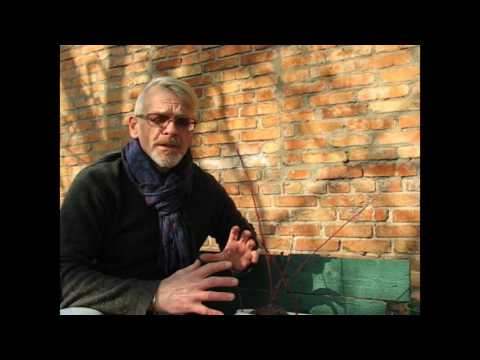

Watch this video on YouTube
White derain care
Despite the fact that the white dogwood is distinguished by its unpretentiousness, it still needs to be well looked after. It should be looked after in almost the same way as for other horticultural crops.
Watering
Particular attention should be paid to watering young, immature bushes. They are watered regularly 1 or 2 times every 7 days. More mature shrubs need watering only during prolonged drought. So, in the summer during a drought, it will be enough to pour from one and a half to two buckets of water under each bush 2 or 3 times a month. When the bush is watered, loosen the soil surface in the trunk circle and pull out all the weeds.
Fertilizer
White turf does not need feeding, especially if the soil on the site is saturated with nutrients. However, if you want the bush to be powerful and bloom profusely, then in the springtime, 100 to 150 grams of the mineral complex should be added to the soil of the trunk circle, and in the summertime, from 5 to 7 kilograms of humus or compost.
Pruning
After the shrub is 3 years old, they begin to carry out systematic formative pruning. If this rule is neglected, then the white deren will soon begin to gradually bare the lower part of the bush. In order for the shrub to be always compact and attractive, every third or fourth stem should be completely cut off. All weakened, injured and diseased branches are also cut out, leaving only the strongest and most developed. If white turf is used to create a hedge, then the first shearing should be done in July, and again in August (when the stems grow).
If you grow varieties whose bark has a bright color, then they are sheared only once for several years, and this procedure is carried out in early spring, before the buds open. In this case, the bush should be shortened to 20 centimeters from the soil surface, which will allow it to rejuvenate: it will begin to actively grow a large number of young branches.
You can shape the crown of a deer in various ways. The most popular options are: arc, cube, column, hemisphere and ball. Another crown of such a shrub can be formed in the form of a standard tree (in 1 trunk). Some of the varieties and varieties of this plant do not need formative pruning, since the shape of their crown is already quite attractive. However, all the same, such bushes are regularly subjected to sanitary pruning.


Watch this video on YouTube
Diseases and pests
An adult, powerful shrub of white deren has a high resistance to diseases and pests. But while the shrub is young, it is often affected by powdery mildew, and pests such as aphids and comma-shaped scale insects can also settle on it.
In a plant affected by powdery mildew, a whitish bloom forms on the surface of the foliage in spring. Cut off all diseased branches as soon as possible and treat the plant with Fundazole solution or Bordeaux mixture (1%). And to get rid of pests, spray the bush with a solution of acaricide, for example: Aktellik, Bankola, Aktara, Akarin or Biotlin.
Reproduction of white deren
White dogwood can be propagated by generative (seed) and vegetative (cuttings and layering) methods.
Growing from seeds
The seed material of this plant has a very high germination rate (about one hundred percent). Sowing of seeds is carried out in the autumn immediately after they are collected.Since the seeds retain their germination for about 5 years, the sowing can be postponed for the spring, but in this case they will need stratification: in winter they are kept at a temperature of 5 degrees for at least eight weeks. When sowing, remember that there should be no more than 5–15 seeds per 1 square meter of land, which are buried 40–50 mm into the soil. You will not see seedlings soon, often they appear only in the second or third year after sowing. And only after 5-8 years a bush grown from seeds will have a standard size for a given plant. That is why most gardeners prefer to use vegetative methods for reproduction.
Propagation by cuttings
From a powerful and healthy plant in the first days of June, it is necessary to cut off slightly lignified stems, and on each cutting there should be from 7 to 9 buds. Plant the cuttings for rooting in a container filled with a suitable potting soil. Cuttings root best in a greenhouse. During rooting, do not forget to water the cuttings in a timely manner, and also feed them with mineral fertilizers and organic matter. By the first autumn weeks, the cuttings should already be well rooted and can be planted in the garden.
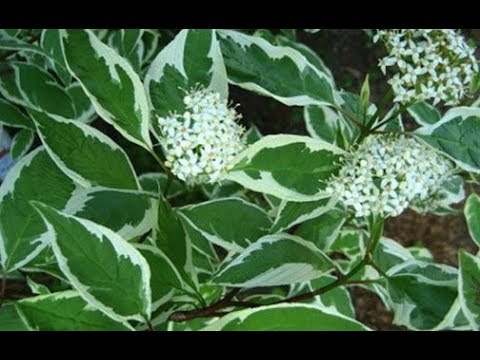

Watch this video on YouTube
Reproduction by layering
The easiest way is to propagate white turf by layering. To do this, in the autumn, select a stem on the bush that grows very low from the ground surface. Dig a small groove and fix the stem in it, leaving only the top outside. Cover the groove with fertile soil. Throughout the summer period, the layers are regularly watered and fed. In late autumn, it is recommended to cover the cuttings with a layer of spruce branches or loose leaves. With the onset of spring or the next autumn period, separate the layers and plant them in a new permanent place.
Deren white varieties
The white deren has a large variety of varieties and several decorative garden forms. The following garden forms are distinguished:
- Argenteomarginate... The bark of such a shrub is red, and its green foliage has a whitish-cream border. In autumn, the leaves turn a carmine red hue. Most of all, gardeners value such a variety of this form as Elegantissima: the stems of three-meter bushes are red, the foliage has an uneven whitish-cream edging, as well as cream stripes and specks.
- Siberica... This undersized shrub has deep red stems. The greenish foliage changes its color to brownish red in autumn. Popular varieties:
- Siberica Variegata - at a two-meter shrub, the foliage is decorated with a wide border of a creamy shade, and also creamy strokes and spots, in autumn it acquires a purple hue, the variety is similar to Elegantissim, but it grows more slowly, which allows it to decorate small gardens;
- Aurea - the two-meter bush has pale red stems, light yellow foliage, whitish-cream inflorescences and white-blue fruits.
- Kern... On the surface of the green foliage there are specks of a yellow tint.
- Shpet... This form was born about 100 years ago. The height of the bush is about 200 cm, its stems are reddish-brown, and the green foliage is decorated with an uneven edging of a yellow-golden hue. In the fall, the foliage turns purple.
- Kesselrings. The stems are colored black-purple or reddish-black.
The following varieties are popular:
- Astrosanguinea... The one and a half meter bush has raspberry stems and green foliage.
- Allemans Compact... While the stems are young, they are colored red. The color of the leaves is rich green.
- Aurea Elegantissima... The two-meter shrub is decorated with yellow-feathery foliage.
- Blood Good... The height of the bush varies from 200 to 300 cm. The color of the foliage and stems is coral red.
- Gochaulti (Guhalti, or Gusholti)... On the blood-red stems, slightly drooping green leaf plates grow with specks of pink, white or red.
- Ivory Hallow... The ball-shaped crown consists of red-colored stems and green leaf plates, decorated with a creamy white wide border.
- Siberica Ruby... The stems of the one and a half meter bush are red-coral. Dark green, rounded foliage, turning purple-red in autumn.
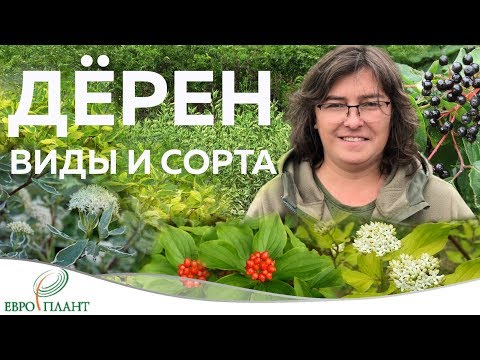

Watch this video on YouTube
Derain white in landscape design
Derain white is often used to create a hedge, as it is very plastic and tolerates a haircut well. Singly and in groups, flowering and variegated forms and varieties look very attractive.
This plant is also often used to strengthen the shores of an artificial reservoir, since it does not suffer from stagnant liquid in the soil, and looks good next to hosts and other coastal perennials. This shrub is also often planted in areas with multi-level complex relief. Also, such a plant is often planted in the shade of large trees.
And also white dogwood looks favorably against the background of evergreens, as it has spectacular foliage and stems. This culture retains its attractiveness throughout the growing season, which is its main advantage.

